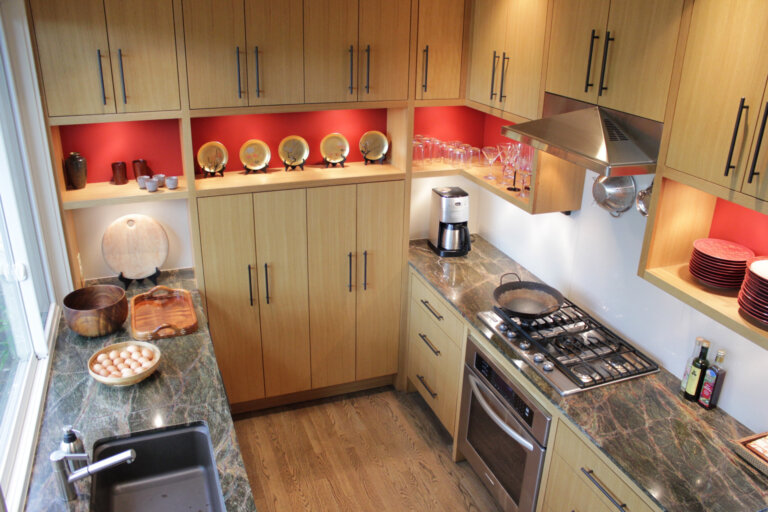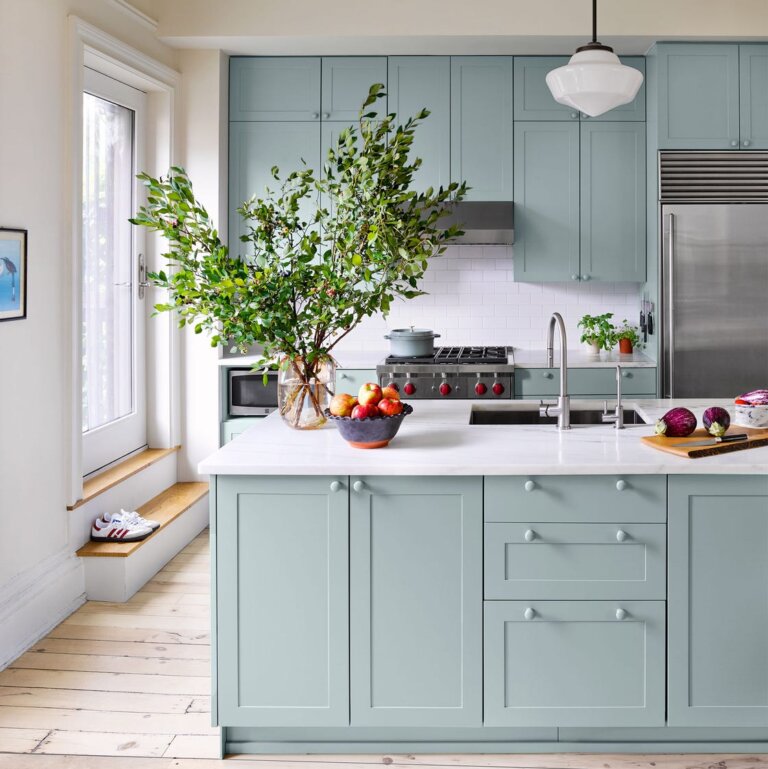Imagine stepping into a kitchen where the warmth of the Mediterranean sun seems to glow from every corner, and the aroma of freshly prepared tapas fills the air. Spanish kitchen design captures this essence beautifully, blending tradition with a lively, inviting atmosphere.
If you’re looking to transform your kitchen into a space that radiates charm and hospitality, you’re in the right place. This article will guide you through the key elements that make Spanish kitchens so unique and irresistible. From rustic textures and vibrant colors to functional layouts, you’ll discover how to infuse your home with the soul of Spain.
Keep reading to unlock the secrets of Spanish kitchen design and bring a touch of sun-drenched elegance into your daily life.
Key Elements Of Spanish Design
Spanish kitchen design is a captivating blend of warmth, vibrant colors, and traditional elements that transport you to the heart of Spain. The key elements of Spanish design create a unique and inviting atmosphere, incorporating rustic charm and Mediterranean influences. From the use of warm wood finishes to the incorporation of handcrafted tiles, Spanish kitchens are a testament to timeless beauty and functionality.
Warm Wood Finishes
Warm wood finishes are a staple in Spanish kitchen design. They evoke a sense of coziness and earthiness that is central to Spanish interior design. Whether in cabinetry or flooring, wood adds character and depth. Choose oak, walnut, or pine for an authentic touch.
Mediterranean Style Kitchens
Mediterranean style kitchens are known for their open concept layout and airy feel. This design invites natural light, creating a welcoming space. Open shelving and large windows are common features that enhance this style.
Spanish Interior Design
Spanish interior design embraces traditional Spanish architecture. Arched doorways and stucco walls are characteristic elements. These features add an old-world charm to modern kitchens.
Rustic Kitchen Decor
Rustic kitchen decor includes elements like exposed beams and rough-hewn tables. These features provide a lived-in feel, making the kitchen a comfortable gathering place.
Traditional Spanish Architecture
| Feature | Description |
|---|---|
| Arched Doorways | Classic architectural element that adds elegance. |
| Stucco Walls | Provides texture and Mediterranean flair. |
Wrought Iron Accents
Wrought iron accents bring a touch of sophistication. Items like light fixtures or cabinet handles crafted from wrought iron add a distinctive and traditional look.
Vibrant Color Schemes
Vibrant color schemes are a hallmark of Spanish kitchens. Bold reds, deep blues, and sunny yellows create a lively environment. Use these colors in tiles, walls, or decor pieces.
Handcrafted Tiles
Handcrafted tiles are often used as backsplashes or flooring. These tiles display intricate designs and rich colors, adding artistic flair to the kitchen.
Farmhouse Sinks
- Deep basins for practicality.
- Classic style that complements rustic decor.
- Durable and easy to maintain.
Open Concept Layout
An open concept layout makes the kitchen the heart of the home. This design promotes interaction and easy movement. It’s ideal for hosting family and friends.
Color Palettes
Spanish kitchen design is known for its vibrant and inviting color palettes that reflect the warmth of the Mediterranean. The use of colors in Spanish kitchens creates a lively atmosphere that combines rustic charm with elegance. A well-thought-out color scheme can transform your kitchen into a cozy and stylish space. Let’s explore some of the color palettes that define Spanish kitchen design.
Warm Earth Tones
Warm earth tones are a hallmark of Spanish kitchen design. These colors create a welcoming and rustic ambiance, reminiscent of sunlit Mediterranean landscapes. Common hues include deep reds, rich browns, and golden yellows. These colors can be seen in terracotta tiles, which add a natural and warm feel to any kitchen.
Here are some elements that often feature warm earth tones:
- Traditional Cabinetry: Often crafted from dark woods, these cabinets add depth and warmth.
- Rustic Kitchen Ideas: Incorporating natural materials like wood and stone enhances the earthy feel.
- Farmhouse Sinks: These sinks in a deep, earthy tone add a touch of authenticity.
Using a combination of these elements, along with wrought iron details and open shelving, brings out the full potential of warm earth tones in a Spanish kitchen.
Bold Accent Colors
Bold accent colors bring life and vibrancy to Spanish kitchens. By adding splashes of color, you can create a striking contrast against the warm earth tones. This technique highlights features and adds personality to the space.
Consider these ideas to incorporate bold accent colors:
- Spanish-Inspired Decor: Use vibrant colors like cobalt blue and sunny orange in decorative pieces.
- Decorative Ceramics: Add plates or tiles with vibrant colors for a lively touch.
- Mediterranean Style: Incorporate colorful textiles or cushions for a pop of color.
| Element | Suggested Accent Color |
|---|---|
| Wall Art | Turquoise |
| Backsplash | Sunset Orange |
| Rug | Crimson Red |
By carefully selecting bold colors, you can create a harmonious and dynamic look that enhances the Spanish charm of your kitchen.
Materials And Textures
Spanish kitchen design celebrates warmth and tradition through its unique materials and textures. The use of natural elements creates a cozy and inviting atmosphere. This style embraces rustic charm and elegance. It integrates traditional kitchen materials to bring the essence of the Mediterranean into your home. Each material adds a distinct character, making Spanish-style kitchens popular for those seeking a warm, inviting space.
Natural Stone
Natural stone is a cornerstone of Spanish kitchen design. It adds both beauty and durability. These stones are often used for countertops, backsplashes, and flooring. They provide a rustic kitchen design that is both functional and stylish. Common types of natural stone include:
- Granite – Known for its durability and resistance to scratches.
- Marble – Offers a luxurious look with its unique veining patterns.
- Limestone – Provides a softer, more earthy appearance.
Natural stone enhances the warm color palettes often found in Spanish-style kitchens. Its earthy tones complement the open-concept kitchen layout, creating a seamless flow from one area to another. The use of stone gives a timeless feel, aligning with the Mediterranean kitchen decor.
Wood Features
Wood features are integral to the charm of Spanish kitchens. They offer warmth and authenticity. Handcrafted wood cabinets are a staple in these kitchens. They showcase intricate craftsmanship and add character. Popular wood types include:
| Wood Type | Characteristics |
|---|---|
| Pine | Light, rustic, and easy to work with. |
| Oak | Strong, durable, and has a traditional look. |
| Cedar | Fragrant, resistant to decay, and rich in color. |
Wooden beams and accents enhance the rustic kitchen design. They provide depth and warmth. These features blend seamlessly with terracotta flooring, another traditional kitchen material. Together, they create a cohesive and inviting atmosphere.
Ceramic Tiles
Ceramic tiles are a hallmark of Spanish kitchen design. They offer versatility and beauty. Spanish tile patterns are vibrant and full of character. They are used for backsplashes and decorative elements. These tiles contribute to the warm color palettes found in Spanish kitchens. Key features of ceramic tiles include:
- Durability – Resistant to water and stains.
- Variety – Available in numerous patterns and colors.
- Easy Maintenance – Simple to clean and maintain.
Decorative ceramic accents add a touch of artistry. They are often handcrafted, emphasizing the traditional craftsmanship found in Spanish kitchens. Incorporating these tiles into an open-concept kitchen layout ties together the space, highlighting the Mediterranean kitchen decor.
:strip_icc()/spanish-kitchen3-723f63cb0dda415099d5d15da98d753d.jpg)
Credit: www.mydomaine.com
Furniture Styles
Spanish kitchen design offers a unique blend of elegance and warmth. This style is known for its vibrant colors, terracotta tiles, and Mediterranean charm. The furniture styles play a pivotal role in bringing this aesthetic to life. Rustic furniture and handcrafted items are key elements that define Spanish decor. They provide a cozy ambiance while reflecting cultural heritage.
Rustic Pieces
Rustic furniture is a cornerstone of Spanish kitchen design. These pieces often feature warm tones and natural materials. Wooden tables and chairs with distressed finishes are common. They add a sense of history and character to the space.
Key features of rustic furniture include:
- Sturdy wooden construction
- Wrought iron accents
- Natural imperfections
Incorporating rustic pieces can be done through:
- Open shelving for displaying handcrafted ceramics
- Vintage lighting fixtures
A table showcasing rustic furniture options:
| Item | Description |
|---|---|
| Wooden Table | Large, distressed finish, ideal for family gatherings |
| Iron Accents | Decorative, adds charm and elegance |
Handcrafted Items
Handcrafted items are vital in enhancing the Spanish kitchen’s authenticity. These pieces often include detailed carvings and unique designs. Handcrafted ceramics are popular for their vibrant colors and intricate patterns. They serve both functional and decorative purposes.
Benefits of handcrafted items include:
- Unique, one-of-a-kind designs
- High-quality craftsmanship
- Reflects cultural heritage
Consider adding:
- Terracotta tiles with Mediterranean style patterns
- Custom-made pottery for a personal touch
Integrating handcrafted items can elevate the kitchen’s look. They bring a personalized and warm atmosphere. The use of vibrant colors and traditional motifs creates a welcoming environment.
Lighting Choices
Lighting choices in Spanish kitchen design play a crucial role in creating the warm and inviting atmosphere that is characteristic of this style. Spanish decor often includes vibrant color palettes and rustic kitchen ideas that are complemented by thoughtful lighting elements. The right lighting can enhance the Mediterranean style, highlight unique features like open shelving and traditional cabinetry, and bring out the beauty of natural materials such as wrought iron accents and tiled backsplashes. Whether you’re planning to include farmhouse sinks or other charming details, lighting is key to achieving the desired ambiance.
Wrought Iron Fixtures
Wrought iron fixtures are quintessential in Spanish kitchen design, offering both elegance and durability. These fixtures can be seen in various forms, from pendant lights to chandeliers, each providing a distinct touch of authenticity. They pair beautifully with vibrant color palettes, allowing the rich hues to shine while adding a rustic charm.
- Elegance and Durability: Wrought iron is known for its strong and lasting nature.
- Variety of Forms: Available as pendant lights, chandeliers, and wall sconces.
- Complementing Rustic Kitchen Ideas: Perfect for enhancing rustic themes.
These fixtures often feature intricate designs that echo traditional Spanish patterns. The dark metal finish contrasts beautifully with natural materials like wood and stone. Use wrought iron accents to highlight specific areas of the kitchen, such as above a farmhouse sink or near tiled backsplashes.
| Type | Feature | Benefit |
|---|---|---|
| Pendant Lights | Focus on specific areas | Enhanced task lighting |
| Chandeliers | Centerpiece | Creates focal point |
| Wall Sconces | Ambient lighting | Softens atmosphere |
Natural Light Integration
Natural light integration is a hallmark of Spanish kitchen design. Embracing sunlight not only illuminates the space but also complements the vibrant color palettes and Mediterranean style. Large windows and open shelving maximize light exposure, creating an airy and inviting environment.
- Maximizing Sunlight: Large windows let in ample natural light.
- Open Shelving: Allows light to flow freely.
- Enhancing Traditional Cabinetry: Brightens and highlights wood textures.
Natural light enhances the beauty of natural materials such as stone countertops and wooden beams. It highlights the intricate designs of wrought iron accents and brings warmth to tiled backsplashes. Consider using light-colored curtains or blinds to control light intensity while maintaining the airy feel.
The strategic placement of windows can also offer views that are reminiscent of Mediterranean landscapes. This connection to nature further enriches the rustic kitchen ideas inherent in Spanish decor. Use natural light to emphasize key features like farmhouse sinks or traditional cabinetry, creating a seamless blend of style and functionality.
:max_bytes(150000):strip_icc()/spanishkitchenwoodexposedbeamscobaltbluevikingstove-ce2ab46eca5c4f739b7fa0efc8ff1110.jpg)
Credit: www.thespruce.com
Outdoor Integration
Spanish kitchen design captures the essence of tradition and warmth. One key feature is the seamless outdoor integration. This design concept embraces nature and brings it indoors. It creates a perfect blend of rustic charm and modern elegance. By merging indoor and outdoor spaces, homeowners can enjoy the beauty of the environment. Outdoor integration enriches the kitchen experience with fresh air and natural light.
Patios And Terraces
Patios and terraces are essential in Spanish kitchen design. They extend the living space and provide a perfect setting for family gatherings. These areas often feature rustic style elements and vibrant colors. Open spaces are adorned with wrought iron furniture and tile patterns that reflect traditional aesthetics.
To enhance the Spanish decor, consider the following:
- Use natural materials like stone and terracotta for flooring.
- Incorporate wooden beams for a rustic touch.
- Opt for vibrant colors in cushions and table settings.
A patio table can serve both functional and aesthetic purposes. Here’s a simple layout:
| Feature | Material |
|---|---|
| Table | Wrought Iron |
| Chairs | Wood |
| Flooring | Terracotta |
Patios and terraces embody the Mediterranean influence. They connect the kitchen to the lush garden, creating a serene atmosphere.
Garden Influence
Gardens play a pivotal role in Spanish kitchen design. They bring nature closer to the heart of the home. The garden’s natural beauty influences the kitchen’s decor, promoting a harmonious balance. Traditional aesthetics are reflected in the choice of plants and ornaments.
Consider these elements for a garden-inspired kitchen:
- Plant herbs like rosemary and thyme near kitchen windows.
- Use natural materials such as clay pots for plants.
- Include tile patterns with floral motifs in the kitchen design.
Gardens influence the choice of colors and materials used in the kitchen. The use of vibrant colors replicates the hues found in nature. Wooden beams and natural materials create a rustic style that blends seamlessly with the outdoor environment.
The integration of garden elements enriches the kitchen’s Mediterranean influence. It offers a refreshing and inviting space for cooking and dining.
Cultural Influences
Spanish kitchen design reflects a rich tapestry of cultural influences that have evolved over centuries. This style is known for its warm and inviting atmosphere, often featuring elements that echo the country’s diverse history. From the intricate patterns of Moorish design to the expressive strokes of traditional Spanish art, these kitchens offer a unique blend of historical and cultural depth. The use of vibrant colors, rustic kitchens, and terracotta tiles are just a few aspects that capture the essence of Spain’s Mediterranean style.
Moorish Elements
Moorish elements play a significant role in Spanish kitchen design, creating a connection to the historical architecture of Spain. The influence of Moorish culture is seen in the intricate tile backsplashes and decorative patterns. These elements bring a touch of elegance and exotic flair to the kitchen space.
- Tile Backsplash: Often adorned with geometric patterns, tile backsplashes become a focal point in Spanish decor.
- Wrought Iron Accents: Incorporating wrought iron accents adds a rustic touch, reminiscent of ancient Moorish architecture.
Incorporating such elements can be done through various design choices. The use of terracotta tiles and ceramic pottery can enhance the earthy tones and create a warm ambiance. A table may illustrate the typical Moorish patterns used:
| Pattern Type | Description |
|---|---|
| Geometric | Symmetrical shapes such as hexagons and stars. |
| Arabesque | Flowing, interlaced leaf and vine designs. |
The combination of these elements brings a unique character to the kitchen, making it both functional and aesthetically pleasing.
Traditional Spanish Art
Traditional Spanish art adds a vibrant and expressive dimension to kitchen design. Incorporating art-inspired decor can transform a space, making it lively and colorful.
- Vibrant Colors: Bold hues, such as deep reds and bright yellows, infuse energy into the space.
- Ceramic Pottery: Hand-painted pottery provides an artistic touch, showcasing traditional Spanish craftsmanship.
- Open Shelving: Displaying art and pottery on open shelving creates visual interest.
Spanish art often features lively scenes and expressive forms. Rustic kitchens with farmhouse sinks complement these artistic elements, providing a backdrop that celebrates both function and beauty. A simple layout might include:
- Farmhouse Sinks with painted ceramic tiles.
- Open Shelving displaying colorful pottery.
The integration of traditional art in kitchen design not only enhances the visual appeal but also connects the space with the rich cultural heritage of Spain.
Modern Spanish Kitchens
Spanish kitchen design offers a blend of warmth, tradition, and modern elegance. Modern Spanish kitchens bring a fresh look while embracing classic elements. They merge the charm of Spanish interior design with contemporary functionality. These kitchens are known for their vibrant tile backsplash, handcrafted cabinetry, and rustic kitchen decor. The Mediterranean style often features an open concept layout, allowing for efficient space utilization. A warm color palette with vintage accents completes the inviting atmosphere.
Contemporary Twists
Modern Spanish kitchens are evolving with contemporary twists that add style and practicality. The open concept layout is a popular choice, making spaces feel larger and more welcoming. Efficient space utilization is key, ensuring every inch is functional and beautiful.
Here are some elements that define contemporary Spanish kitchens:
- Tile Backsplash: Bright and colorful, it serves as a focal point.
- Handcrafted Cabinetry: Custom pieces add a unique touch.
- Warm Color Palette: Earthy tones create a cozy feel.
- Vintage Accents: Lamps or chairs enhance the traditional vibe.
A table showcasing key features:
| Feature | Benefit |
|---|---|
| Tile Backsplash | Adds color and character. |
| Handcrafted Cabinetry | Ensures uniqueness and quality. |
| Warm Color Palette | Promotes a welcoming atmosphere. |
Sustainable Practices
Modern Spanish kitchens are embracing sustainable practices. Environment-friendly materials are now a staple in Spanish interior design. These practices not only help the planet but also enhance the kitchen’s appeal.
Here are some sustainable practices to consider:
- Recycled Materials: Use reclaimed wood for cabinetry.
- Energy-efficient Appliances: Reduce energy consumption.
- Natural Lighting: Maximize sunlight to minimize electricity use.
Traditional Spanish elements, such as terracotta tiles, are now sourced sustainably. Rustic kitchen decor made from recycled materials adds charm without harming the environment. Mediterranean style encourages the use of local materials, reducing transportation emissions.
A focus on sustainability aligns with modern values while retaining the beauty of Spanish design. These eco-friendly choices contribute to a healthier home and planet.
Frequently Asked Questions
What Is A Spanish Style Kitchen?
A Spanish style kitchen features warm colors, rustic textures, and natural materials like wood and terracotta. It often includes decorative tiles, wrought iron accents, and arched doorways. The design exudes a cozy, inviting atmosphere with its traditional and Mediterranean influences, creating a charming and functional cooking space.
What Is The Most Popular Kitchen Layout Today?
The most popular kitchen layout today is the L-shaped design. It maximizes space and functionality, offering a versatile cooking area. This layout accommodates dining and social interaction, making it ideal for modern homes. Its efficient design suits both small and large kitchens, enhancing workflow and aesthetics.
What Is Spanish Interior Design Called?
Spanish interior design is known as “Spanish Colonial” or “Mediterranean” style. It features vibrant colors, rustic textures, and ornate woodwork. This style emphasizes natural materials like terracotta, wrought iron, and ceramics. Arches and tiled floors are also prominent, creating a warm, inviting atmosphere.
Spanish design blends tradition and elegance effortlessly.
What Are The Colors Of Spanish Interior Design?
Spanish interior design often features vibrant colors like terracotta, deep reds, sunny yellows, and earthy browns. Rich blues and olive greens add depth. These colors reflect the warm Mediterranean climate and create a welcoming, lively atmosphere. Natural materials like wood and stone complement these hues beautifully.
Conclusion
Spanish kitchen design brings warmth and charm to any home. Earthy tones and rustic elements create a cozy atmosphere. Open spaces invite gatherings and shared meals. Traditional tiles add vibrant colors and patterns. Handcrafted wood accents provide a natural feel.
The blend of old and new styles feels timeless. Embrace the rich culture and elegance in your kitchen. Let the inviting design inspire your culinary adventures. Discover the beauty of a Spanish kitchen and its welcoming embrace. Transform your cooking space into a lively hub of family and friends.
Enjoy the heart of your home with Spanish flair.

My name is Mahi Uddin, and I’m a blog writer with over two years of experience specializing in creating engaging, informative content using AI tools. I contribute to InExDecor.com, where I share creative ideas and practical tips for transforming interior and exterior spaces into beautiful, functional environments. With a passion for storytelling and a knack for blending creativity with technology, I strive to craft blogs that not only inform but also inspire readers. When I’m not writing, you can find me exploring design trends or enjoying a good book with a cup of coffee.








